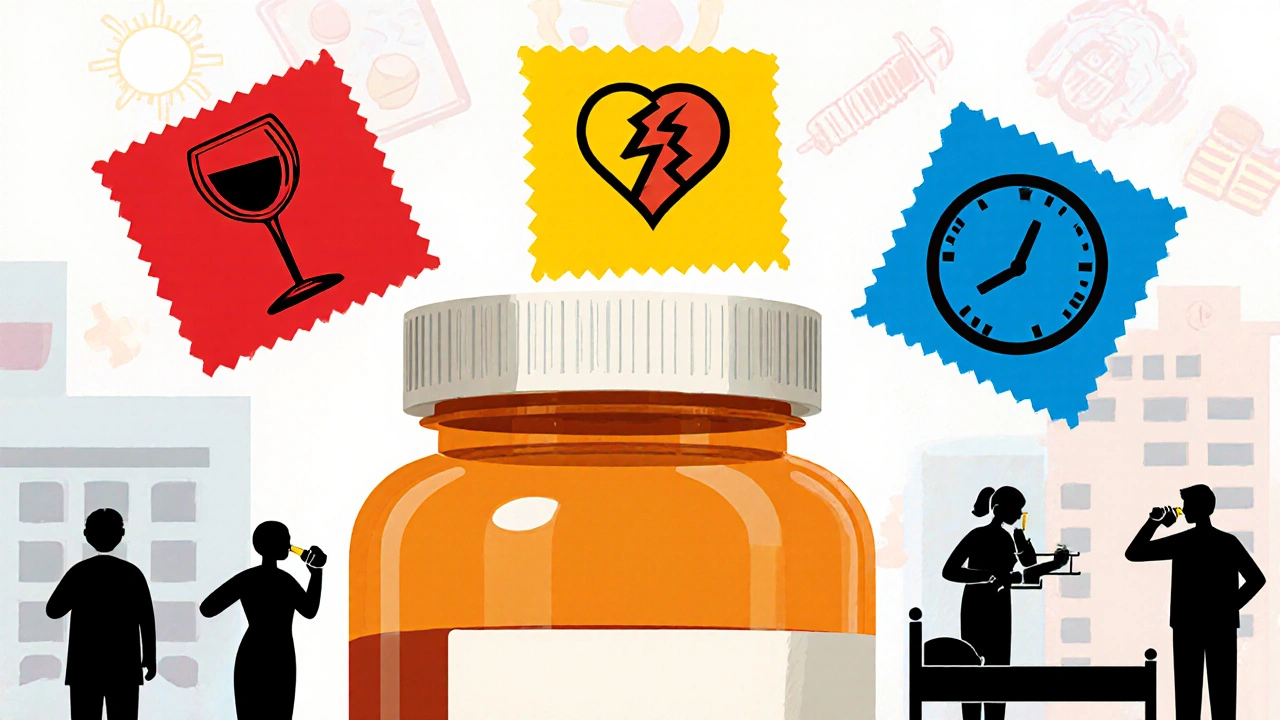 26
Nov,2025
26
Nov,2025
Every time you pick up a prescription, there’s a small sticker on the bottle. Maybe it says "Do not drink alcohol", or "Take on empty stomach", or "May cause drowsiness". You might glance at it, shrug, and toss it in your bag. But those stickers aren’t just paperwork-they’re your last line of defense against serious harm.
Here’s the truth: 64% of people have ignored at least one warning on their prescription label. Some skip the "avoid sunlight" note because they think it’s just a suggestion. Others chew a pill labeled "swallow whole" because they can’t swallow pills. One woman in Melbourne threw away the paper warning about grapefruit juice and ended up in the ER with dangerously low blood pressure. These aren’t rare mistakes. They’re happening every day-because most people don’t know what those labels really mean.
What the Colors on Your Prescription Label Actually Mean
Not all warning stickers are the same. Color matters. A red sticker isn’t just eye-catching-it’s a red flag. In pharmacy labs and patient surveys, red labels are consistently interpreted as "danger" or "serious risk." If you see red, stop. Read. Ask.
Yellow means "caution." It’s not an emergency, but it’s not optional. Think: "Take with food" or "Avoid driving." Blue or white labels? Those are usually reminders-not warnings. "Refrigerate" or "Take at bedtime" fall here. They’re important, but not life-threatening if missed.
Here’s what you need to know: 42% of patients automatically trust red over blue. That’s good. But 32% of people misread a simple "For external use only" symbol as "radioactive." That’s not your fault. The symbols weren’t designed for you. They were designed for pharmacists. And that’s the problem.
The Black Box Warning: When a Drug Could Kill You
Some medications come with a black box around the warning. This isn’t a design choice. It’s a federal mandate. The FDA requires a black box when a drug has been linked to death or serious injury-like liver failure, heart attacks, or suicidal thoughts.
As of 2023, nearly 4 out of every 10 new drugs approved by the FDA carry a black box warning. That includes common prescriptions like certain antidepressants, blood thinners, and diabetes medications. These aren’t rare drugs. They’re widely prescribed.
But here’s the catch: most patients never see the black box on the bottle. It’s printed on the patient information sheet-often thrown away. The sticker on your bottle might just say "May cause dizziness." But the full warning? It could say "risk of sudden death in patients with heart conditions." That’s why you must read the paper insert. Don’t assume the sticker tells you everything.
"Swallow Whole" vs. "Do Not Crush"-Why It Matters
"Swallow whole" sounds simple. But 30% of patients misunderstand it. Some think it means "don’t swallow it whole," so they crush it. Others think it means "chew it up so it works faster." Both are wrong-and dangerous.
Extended-release pills are built to release medicine slowly over hours. Crush them, and you get the full dose all at once. One man in Sydney crushed his opioid painkiller because he couldn’t swallow it. He died from an overdose. Another patient crushed her blood pressure pill and ended up in the hospital with a heart rate of 40.
Same goes for capsules. Some are designed to dissolve in the intestine, not the stomach. Crush them, and you risk stomach ulcers or nausea. If you can’t swallow a pill, ask your pharmacist. There’s almost always a liquid version, a patch, or a different brand that works better.
"Take on Empty Stomach"-What That Really Means
"Take on empty stomach" isn’t a suggestion. It’s science. Many antibiotics, thyroid meds, and osteoporosis drugs are absorbed poorly-or not at all-if taken with food. That means the drug won’t work.
"Empty stomach" means at least one hour before eating, or two hours after. Not 15 minutes. Not "right before my coffee." A 2021 study showed that 58% of patients took their thyroid medication with breakfast. Their hormone levels stayed dangerously low for months. They thought they were doing fine-until their doctor ran tests.
Same goes for "take with food." Some drugs irritate your stomach. Others need fat to be absorbed. If you’re told to take it with food, don’t just grab a cracker. Eat a full meal. A banana won’t cut it.
Why You’re Still Misreading the Labels
There’s a reason you’re confused. The FDA requires detailed warnings for doctors-but not for patients. The sticker on your bottle is just a summary. The real details are on the 10-page insert you never read.
And here’s the kicker: 80 million American adults have trouble understanding health information. That’s not just about education. It’s about design. Most labels use tiny fonts, complex words like "contraindicated" and "adverse reaction," and symbols that mean nothing to the average person.
One study found that even when the phrase "For external use only" was written at a first-grade reading level, 91% of people still got it wrong. They thought it meant "use on skin," but didn’t realize it meant "do not swallow."
Pharmacies are starting to fix this. Kaiser Permanente uses simple, bold labels: "Do not drive," "May cause dizziness," "Do not mix with alcohol." Their patients understood 89% of warnings. The national average? 55%.
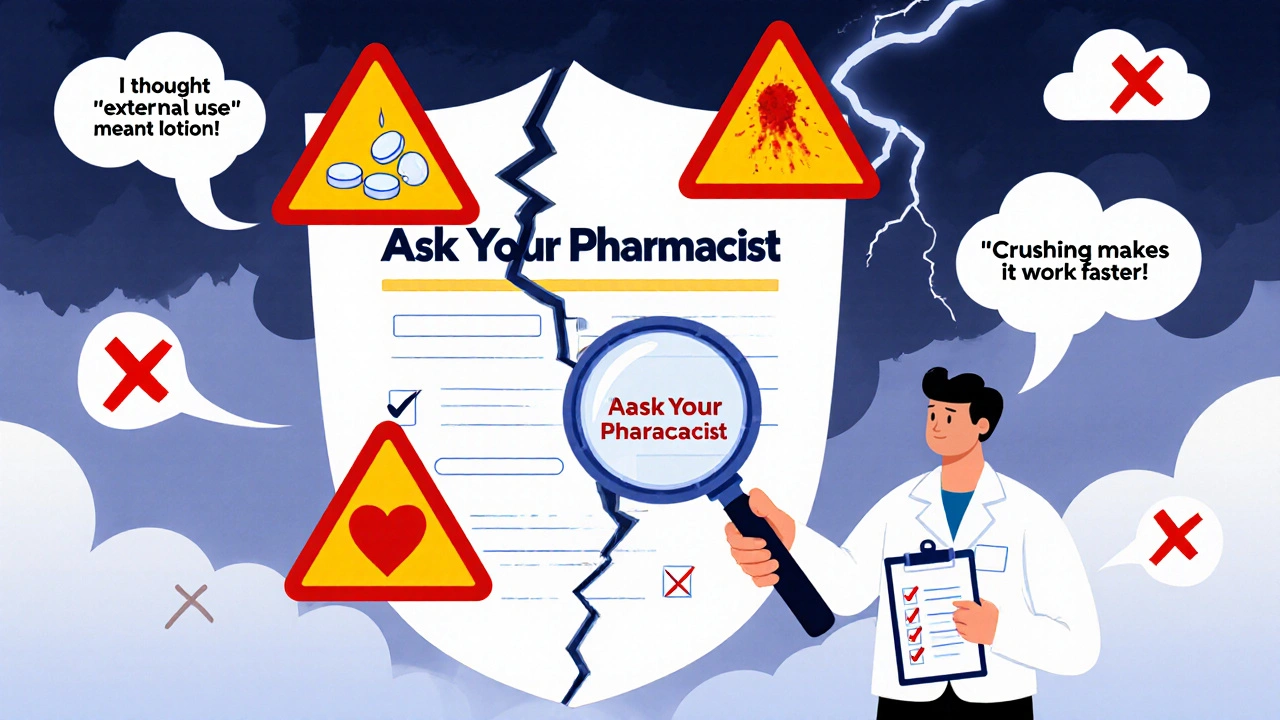
What You Should Do Right Now
You don’t need to be a pharmacist to stay safe. Here’s what to do every time you get a new prescription:
- Check the color. Red = danger. Yellow = caution. Blue/white = reminder.
- Read the sticker. Don’t assume you know what it means. Say it out loud: "What does ‘take on empty stomach’ really mean?"
- Ask your pharmacist. Don’t wait until you’re home. Ask: "Is there anything I absolutely must avoid?" or "What happens if I miss a dose?"
- Use the teach-back method. Repeat the instructions in your own words. "So if I take this with grapefruit, I could pass out?" If they say yes, you got it.
- Save the paper insert. Don’t throw it away. Keep it with your meds. You’ll need it when you see your doctor.
What’s Changing-and When
The system is finally waking up. In 2023, the FDA approved the first universal symbol for "do not crush." Before, it looked like a pill with a line through it-some people thought it meant "take with water." Now it’s a broken pill with a red X. In testing, misinterpretation dropped from 31% to just 8%.
By June 2025, 20 high-risk drug classes will have new "Facts Labels"-simplified, plain-language warnings printed right on the bottle. No more tiny print. No more jargon. Just: "This medicine can cause liver damage. Do not drink alcohol. Call your doctor if you feel very tired or your skin turns yellow."
Some pharmacies are testing QR codes on labels. Scan it, and you get a 30-second video explaining the warning in plain English. Early results show comprehension jumps by over 50%.
But here’s the hard truth: change is slow. There are 67,000 community pharmacies in the U.S. Each one uses different labels. Until every pharmacy follows the same rules, you still need to be your own safety net.
When to Call Your Doctor or Pharmacist
Don’t wait for a crisis. Call if:
- You don’t understand what the sticker means
- You’re taking more than one prescription and aren’t sure how they interact
- You’ve missed a dose and aren’t sure what to do
- You feel strange after starting a new med-even if it’s "just a little drowsy"
Pharmacists are trained to explain this stuff. They want you to understand. But they can’t read your mind. If you’re unsure, speak up. It’s not bothering them. It’s saving your life.
What does a red sticker on my prescription mean?
A red sticker means there’s a serious risk-something that could cause injury, hospitalization, or death. Examples include "Do not drink alcohol," "May cause heart rhythm problems," or "Black box warning: risk of sudden death." Treat red stickers as urgent. If you see one, read the full warning and ask your pharmacist for clarification.
Can I crush my pills if I can’t swallow them?
Only if the label says it’s okay. Most extended-release pills, capsules, and coated tablets should never be crushed. Crushing them can release the full dose at once, leading to overdose. For example, crushing a blood pressure pill can drop your heart rate dangerously low. Always ask your pharmacist for a liquid version, patch, or alternative form.
What does "take on empty stomach" really mean?
It means take the medicine at least one hour before eating, or two hours after. Food can block absorption-especially for antibiotics, thyroid meds, and osteoporosis drugs. Taking it with breakfast or a snack means it won’t work. If you’re unsure, ask your pharmacist to explain exactly how long to wait.
Why do some warnings say "avoid sunlight"?
Some medications make your skin extremely sensitive to UV light. Sun exposure can cause severe burns, blisters, or long-term skin damage-even on cloudy days. Common culprits include certain antibiotics, acne meds like isotretinoin, and some diuretics. Wear sunscreen, long sleeves, and a hat. Don’t assume it’s just a "recommendation"-it’s a safety rule.
Is it safe to ignore a warning if I’ve taken the medicine before without problems?
No. Your body changes. So do your other meds. A warning that didn’t matter last year might be dangerous now if you started a new drug, gained weight, or developed a health condition. Never assume past safety means future safety. Always read the label every time you refill a prescription.
What should I do if I accidentally break a warning?
Don’t panic. Call your pharmacist or doctor immediately. Tell them exactly what you did-"I crushed my pill," or "I had two drinks after taking my antibiotic." They can tell you if you’re at risk and what to watch for. Most adverse reactions happen because people hide mistakes. Speaking up saves lives.

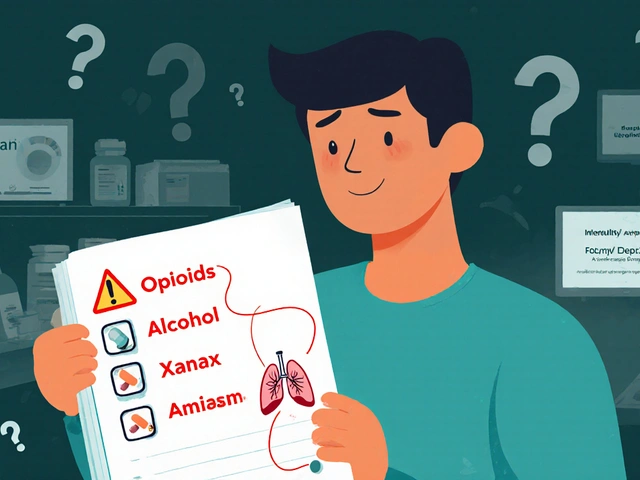
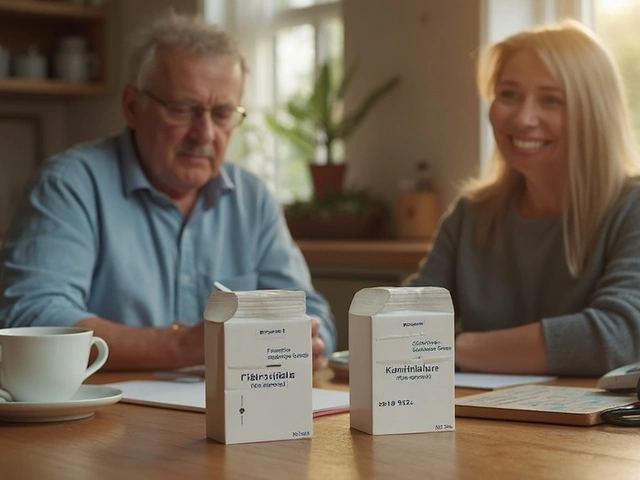

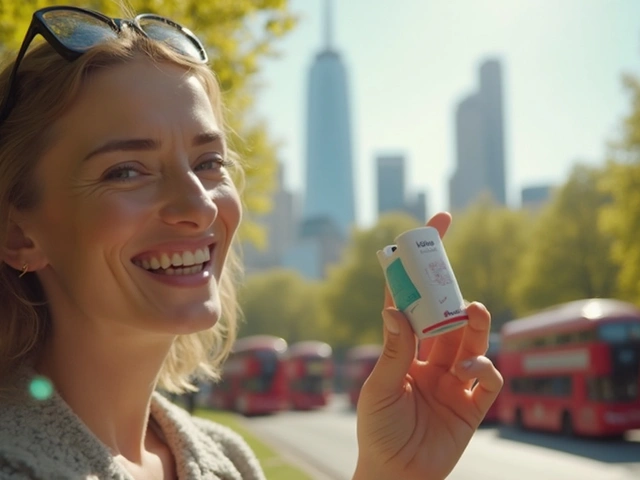
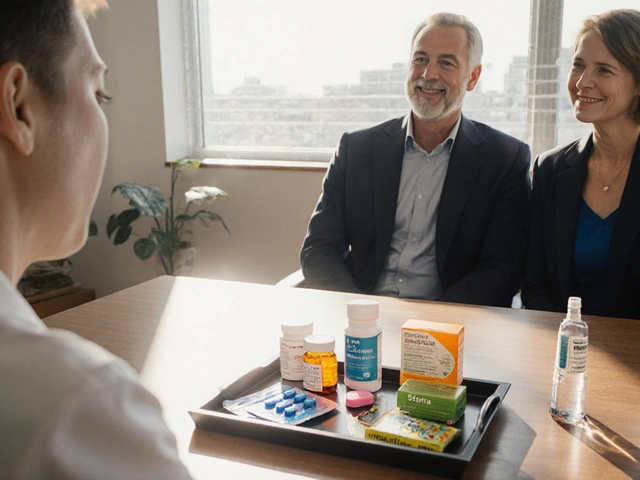
Red sticker? That’s not a suggestion-it’s a siren. I once ignored ‘do not drink alcohol’ with my antibiotic because I thought, ‘It’s just one glass.’ Two hours later, I was vomiting in a bathroom while my husband called 911. I didn’t die, but I learned. Always read the damn sticker. And if it’s red? Stop. Breathe. Ask.
Y’ALL. I work in a pharmacy. I’ve seen people crush pills because they ‘can’t swallow.’ I’ve seen folks take thyroid meds with coffee. I’ve seen someone try to use a ‘for external use’ cream as a face mask. I’m not exaggerating. These aren’t jokes. These are ER visits waiting to happen. The system’s broken-but YOU can be the fix. Ask. Read. Don’t guess. Your life isn’t a gamble.
so i just found out that ‘take on empty stomach’ means no food for 2 hours before? i’ve been taking mine with toast since 2020… oops. also, i thought ‘swallow whole’ meant don’t swallow it whole?? lol. my bad. thanks for the post.
Let’s be real: the FDA doesn’t design labels for patients. They design them for lawyers. And pharmacies? They print them on 6-point font because ‘space is limited.’ But here’s the irony-we blame patients for not understanding when the system is actively designed to confuse us. The solution isn’t ‘read the insert’-it’s systemic reform. Plain language. Universal symbols. Mandatory pharmacist consultation. Until then, we’re all just guessing in the dark.
Black box warnings? That’s the FDA’s way of saying, ‘This drug could kill you, but we’re still selling it.’ And guess who pays the price? The patient. The ‘may cause dizziness’ sticker? That’s the sanitized version. The real warning says ‘risk of torsades de pointes, QT prolongation, sudden cardiac death.’ But you’ll never see that on the bottle. So yeah-read the insert. Or don’t. Just know: your pharmacist isn’t your enemy. They’re the only one who knows what’s really inside that pill.
I used to throw away the inserts. Then my mom had a bad reaction to a blood thinner because she didn’t know it interacted with her new fish oil. She ended up in the hospital. Now I keep every insert in a folder labeled ‘Medications.’ I even write notes in the margins. It’s not glamorous, but it’s saved my family. If you’re not reading it-why not start today?
why do they make it so hard? just say dont drink if its red. why all the fancy words? i dont need a thesis to know dont mix pills with booze. also why so many colors? just make it red or green. simple.
My grandmother, who immigrated from Mexico, once took her blood pressure pill with grapefruit juice because she thought it was ‘healthy.’ She ended up with a near-fatal drop in BP. No one told her. The label didn’t say ‘grapefruit’-it said ‘citrus.’ She didn’t know the difference. Language matters. Clarity matters. We need labels that speak to everyone-not just the educated.
Oh, so now we’re blaming patients for not being pharmacists? 🙄 How about we stop pretending that a 6-point font on a 2-inch sticker is ‘accessible’? The real problem? Pharma companies prioritize profit over patient safety. They lobby to keep jargon. They fund studies that prove ‘patients are dumb.’ Wake up. This isn’t about education. It’s about corporate negligence. And no, I won’t ‘read the insert’ if it’s written in Latin.
I’ve started asking my pharmacist to explain every new prescription like I’m five. They always laugh, then thank me. Turns out, most of them are just happy someone actually listens. So yeah-I ask. I repeat. I write it down. It’s not weird. It’s smart.